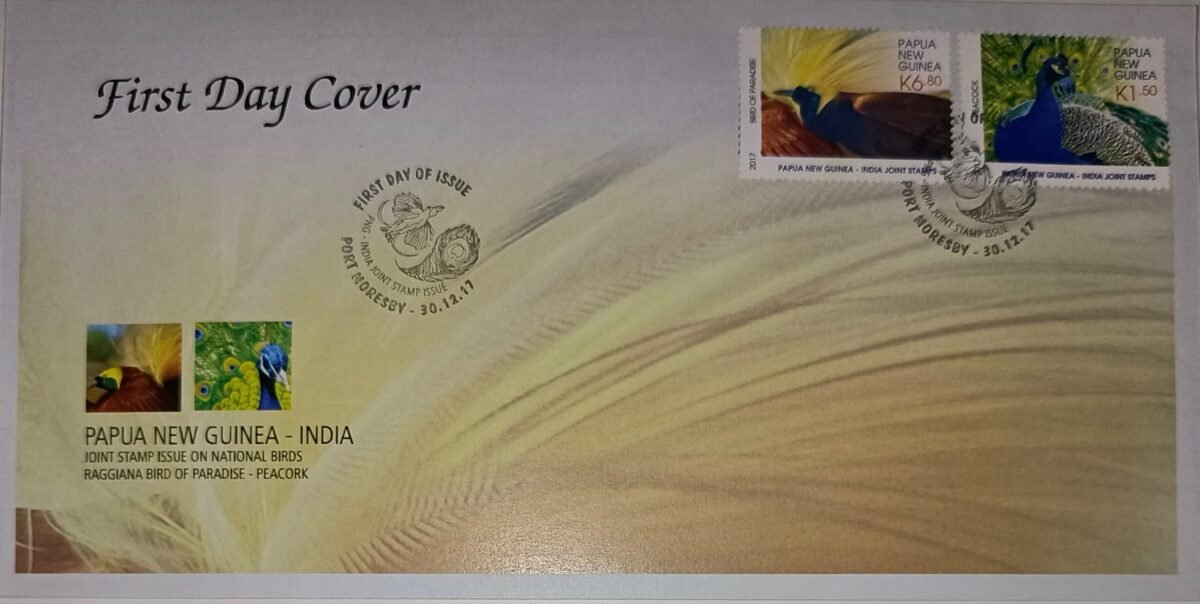The Raggiana Bird of Paradise

Technical Data
| Stamp Set | India-Papua New Guinea : Joint Issue |
|---|---|
| Date of Issue | December 30, 2017 |
| Denomination | Rs. 5 |
| Quantity | 210,000 |
| Perforation | 13¼ x 13¾ |
| Printer | Security Printing Press, Hyderabad |
| Printing Process | Wet Offset |
| Watermark | No Watermark |
| Colors | Multicolor |
| Credit (Designed By) | Smt. Alka Sharma |
| Catalog Codes |
Michel IN 3305A Stamp Number IN 2984 Yvert et Tellier IN 2996 Stanley Gibbons IN 3430 |
| Themes | Animals (Fauna) | Birds | Joint Issues |
A National Treasure of Papua New Guinea
The Raggiana Bird of Paradise (Paradisaea raggiana), affectionately known as the Kumul, is one of the most admired avian species in the world. As the National Bird of Papua New Guinea, it is a symbol of pride, identity and natural splendour for the nation. In 1971, its significance was officially recognised when the Raggiana Bird of Paradise was adopted as the national emblem, featured prominently on the national flag and inspiring the name of the country’s national rugby league team—the Kumuls.
A Brilliant Display of Colour and Majesty
Measuring about 34 cm in length, the Raggiana Bird of Paradise captivates with its rich colours and ornamental plumes. The male, in particular, displays a vivid yellow crown, emerald-green throat, and a bright yellow collar over its dark upper breast. Its most distinctive feature is a pair of long, elegant tail wires accompanied by large, flowing flank plumes that range in shades from fiery red to glowing orange.
The female is more subdued in appearance, with a maroon-brown body and without the elaborate tail feathers. This subtle colouring aids in nesting and protection.
A Vital Part of New Guinea’s Ecosystem
The Raggiana Bird of Paradise has a fruit-based diet, supplemented by arthropods. It plays a key ecological role as a major seed disperser, especially for several species of mahogany and nutmeg trees, helping maintain the biodiversity of New Guinea’s forests.
Unique Courtship Rituals and Breeding Behaviour
A fascinating aspect of this species is its polygamous breeding system. The males gather in groups known as leks—natural display arenas that may stretch across 30 to 100 metres. Here, they perform elaborate mating dances to attract females, creating one of the most enchanting courtship spectacles in the bird world.
The nest is generally placed 2 to 11 metres above the ground on tree branches and crafted using leaves, ferns, stems and plant fibres, lined with soft, hair-like materials.
Commemorative Stamp Issue: Celebrating Indo-Papua New Guinea Friendship
To honour the warm and growing diplomatic relationship between India and Papua New Guinea, the postal administrations of both nations collaborated to release a joint commemorative stamp issue. This special release features each country’s national bird—the Peacock of India and the Raggiana Bird of Paradise of Papua New Guinea—symbolising friendship, cultural pride and shared values between the two Commonwealth nations.
This philatelic tribute beautifully captures the essence of both countries’ natural heritage and their commitment to strengthening bilateral ties across cultural, scientific, educational and economic domains.
First Day Cover


Leave a Comment
You must be logged in to post a comment.